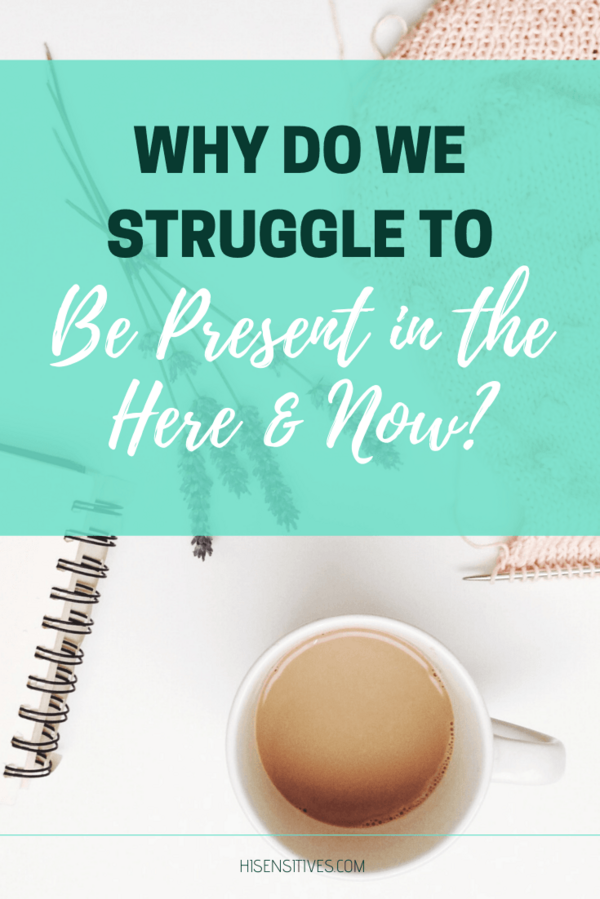As a highly sensitive person it is common to overthink and be stuck in the past or the future. In this blog, I explain how to be more present in the here and now.
Hey there, lovely readers! We want to be completely transparent with you. Some of the links in this blog are affiliate links, which means if you click on them and make a purchase, we may earn a small commission at no additional cost to you. 😊
We only recommend products and services we genuinely believe in and have personally used or researched. Your support through these links helps us keep bringing you valuable content, so thank you for being amazing!
Estimated reading time: 17 minutes
Do you feel the desire to be more present in the here and now?
Are your thoughts preventing you over and over again from achieving this?
Do you feel that your trait as a highly sensitive person is blocking your path towards a more mindful and present life?
Keep on reading, because I have investigated further on the topic of HSP’s and mindfulness and found some interesting insights!
Here’s What You’ll Learn:
What Does It Mean To Be A Highly Sensitive Person?
In order to truly learn how to be more present in the here and now as an HSP, it is important to know how highly sensitive people tick.

15-20% of the world population are highly sensitive people. That is 1 in 5!
Highly sensitive people process sensory stimuli more intensely. Because we pick up on every tiny signal around us, we tend to feel more easily overwhelmed.
Loud noises, bright lights, specific smells are all external sensory stimuli that might result in overstimulation within a highly sensitive person.
In addition, a highly sensitive person has a heightened amount of active mirror neurons, which results in high levels of empathy.
We are excellent at understanding what the other person is going through and have a tendency to pick up on their energy quite naturally.
Another common trait for highly sensitive people is that we have an increased depth of processing what is going on around us. This might result in hours and hours of overthinking.
All these aspects that come along with being a highly sensitive person, might feel like roadblocks on the path towards a life in the present.
But don’t worry, it is not impossible for highly sensitive people to learn how to be present in the here and now!
In this blog, you will learn why you as an HSP might struggle to be present in now. Also, you will read why it is important to be more present in the here and now. Finally, you will receive some practical tips on how to achieve that.
Why Do We Struggle To Be Present In The Here And Now?
Being present in the here and now is a common theme that has been introduced thousands of years ago.
“If you think about history, you will be depressed. If you think about the future, you will have anxiety. If you think about the present, you will be in peace. ” – Lao Tse. 2000 years ago.
New-age philosophers, Buddhists, our modern psychology and thousands of other resources preach about the importance of putting your regrets about the past and your worries and anxious thoughts about the future aside to make more room for the present.
While it seems so easy in theory, the practical execution of this idea is a tough nut to crack. Why is it so hard for us to bring our mind to the present? There are two obvious reasons: cognition and evolution.
Our intelligent cognition denies the existence of the present. It is almost impossible for our mind to grasp the concept of it, because it views time as a constant and linear process.
To be more specific, any second before the now is the past and every second after the current moment is the future. No wonder our minds struggle to be present in the here and now!

The other factor that plays a major role when it comes to struggling to be more present is evolution.
It is our awareness that sets us as humans apart from other species. Evolution has hardwired human psychology to focus on the past and the future.
Learning And Planning
While other species’ instincts and reflexes are wired to help them survive, the survival of humans is founded on learning and planning.
In order to be able to learn, you have to look at the past for mistakes, so you won’t make them again. Feelings such as regret and guilt are our mind’s way to tell us to learn from our faults and not make them again.
For planning, a look into the future is necessary. Thoughts about what is going to happen in the future is essential in the process of motivating us. It motivates us to spend time on doing something displeasing today for the benefits of our future well-being and happiness.
Without looking into the past, we wouldn’t learn from our mistakes. Without focusing on the future we would stand still. We simply would not grow. Therefore, it is not a bad thing to be thinking about the past and the future. It is human.
How Does The Cognition- & Evolution Theory Work When You Are Highly Sensitive?
While every human thinks about the past and the future, highly sensitive people are wired to do this on an even deeper level!
The capability to process external stimuli more deeply compared to non-hsp’s is a strategy to pause to check, observe and reflect on the things that we already have noticed, before undertaking further action.
It is a survival strategy that involves observing before taking any further steps. Way back in time, when danger was around every corner, this was a necessary skill for the group to survive.
So next time you are harsh on yourself for focusing much on the past and the future, know that this is an evolutionary trait which actually brought the human race to this point.
Nevertheless, it would be nice to switch off this skill every now and then and to be more present in the here and now, wouldn’t it? Let me tell you why this is an important skill to master.

Why Be Present In The Here And Now?
While most of us like to think that we have control over the future, the here and now is actually where we are fully in control.
Also, the present moment is the place where you will feel the most comfortable. This is the only place where you truly can control your level of happiness.
Studies have shown that there is a correlation between happiness and being present in the here and now.
They claim that your happiness does not occur from the things that happen to you or happened to you in the past. Happiness occurs from being able to master your mind, thoughts, mindset and attitude.
It is impossible to control how you feel about a certain situation in the presence, but you do always have the power to control how you think.
50% of your happiness are determined by your genes and 10% by your circumstances. However, there still are 40% of your happiness which you are in full control of.
I know, it sounds incredibly challenging and it is. Most of us don’t take on our thoughts in full awareness, but rather let thoughts control us.
How Your Mind Is Blocking You From Happiness
Have you ever caught yourself in a situation where you were triggered by something specific and you let your mind wander off to a degree where your level of happiness was affected? I certainly have. Let me give you an example.
Whenever I see a dog being put to sleep, I start to think that I have to put my dog to sleep somewhere far away in the future. Then another thought occurs where I think about how sad that moment will be. Consequently, my body starts to react to those thoughts and I feel sad and on the verge of crying. See what my mind did there?
This example shows how one current thought can affect your happiness in the present. I let my mind wander off into the future instead of saying to myself “Hey, we still have many years to go, enjoy the here and now with your dog!”.
So instead of being sad or upset about things that might or will happen in the future, focus on your current situation. What is happening in the here and now? Focus on your thoughts, mindset and attitude. This is called mindfulness.
The Benefits Of Mindfulness
There are many benefits that come along with being present in the here and now and mindful living.
For example, mindfulness results in decreasing stress and sadness and increases focus and happiness.
In addition, living a mindful life enhances your ability to deal with illness and pain. Also, it boosts your working memory and reduces emotional reactivity.
All of these benefits can be achieved by living in the here and now. Now that you know why you might struggle to be present in the here and now and why it might be beneficial for you to focus on this, it is time to have a look at the HOW.
How To Be More Present In The Here And Now?
As a true personal growth junkie, I love to try out a variety of practical methods. Below, I have listed scientifically proven methods that you can try to be more present in the here and now.
1. Breathing Meditation
“Breath is the bridge which connects life to consciousness, which unites your body to your thoughts. Whenever your mind becomes scattered, use your breath as the means to take hold of your mind again.” Thich Nhat Hanh, The Miracle of Mindfulness (affiliate link)
A breathing meditation is a powerful tool to bring your mind back to the here and now. You do it continuously and it is part of the here and now.
Because you do it continuously, it is always available! Wherever you are and whenever you feel overstimulated or are overthinking, you can use your breath as a tool to bring your mind back to the here and now.
Science shows that there is a direct biochemical link between your breathing and your brain. Once you put your focus towards your breath, you can control your brain to become more conscious.
By consciously focusing on your breathing, you can shift your brain from the Sympathetic Nervous System (Fight or Flight) to the Parasympathetic Nervous System (Rest and Digest).
Especially for highly sensitive people, who have a tendency to be in fight or flight-mode, this is a crucial technique to bring your mind and body back to the present moment.
If you’d like to give it a try, this breath meditation is wildly popular on Youtube:
2. Body Scan
Another tool you always have available for bringing yourself to the present moment, is your body! By performing a body scan, you can bring your mind back to the here and now within no time.
But what is body scanning? It is a conscious moment where you pay attention to the parts of your body and its sensations gradually from feet up to your head.
Here, you scan your body mentally and bring awareness to every aspect of it. In this process, you notice specific aches, pains, tension or overall discomfort.
By noticing these discomforts, you become aware of them and the fact that they need to be managed in the future.
Studies have shown that body scanning offers benefits such as stress reduction. Reduced stress can result in decreased inflammation, fatigue and insomnia.
If you’d like to try a body scan meditation, you might want to try this one:
3. Touching
For highly sensitive people, this might be a very powerful way to be more present in the here and now.
Simply put your attention towards touch. What touches your skin and body throughout the day? How does it feel?
We undertake many daily actions unconsciously. Activities such as washing our hands or taking a shower are done on auto-pilot while our mind happily wanders off into the past and the future.
By bringing your attention towards the sensation of touch, you become more aware of what is happening right here right now.
So next time it is raining and you are walking outside, focus on the feeling of the rain drops on your skin.
Or when you are walking through the grass, put your attention towards the feeling the grass stalks have on your feet.
This is a simple yet super effective method to bring your mind back to the present moment.
4. Wait For The Next Thought
A powerful method to bring your mind to the present is to wait for the next thought. I came across this method in Eckhart Tolle’s book ‘The Power of Now’(affiliate link).
Here, Tolle asks you to close your eyes and ask yourself what your next thought is going to be.
Then you will become very aware and wait for the next thought, just like a cat who is watching a mouse hole, waiting for the mouse to come out.
You can try this method in combination with a breath meditation. Breathe in deeply 4 times and then breathe out 4 times. Then, bring your breathing pattern back to normal and ask yourself the question ‘What will be my next thought?’.
Focus on the things that arise in your mind. Observe them without judgement. Accept their existence. Then ask yourself the same question again and observe what your next thought is.
You will realize that this is an incredibly powerful way to become more conscious of the here and now.
At the end of this meditation, end with 4 conscious breaths in and out again.

5. Listen Closely To The Words Somebody Is Saying
Have you ever found yourself in a conversation where you weren’t really listening? Instead, you were already making up your answer for what the other person was telling you?
Been there done that! It is a very common thing that many of us do. Especially when you struggle from social anxiety, this is a normal coping mechanism.
However, it takes you away from the present moment. In addition, you might want to ask yourself the question if you really are listening, when you already have your answer ready before the person has finished their sentence.
Listening closely to the words the other person is using is a wonderful way to bring our minds back to the present moment. Additionally, it makes us better listeners. Win-win!
Challenge yourself to get out of your mind and to focus on what the person is actually saying. Try to listen without the intention to respond.
You will notice that you will be more present in the conversation. And another benefit: your conversation partner will most likely experience you as a very good listener.
6. Focus On Movement
Similar to the exercise to focus on touch, you might consider to focus on movement to be present in the here and now.
Focus on the way you move your hands while cooking. Put your attention towards your legs while walking. Focus on your chewing during dinner time.
There are hundreds of movements that we do unconsciously throughout the day. Try to acknowledge some of those automated movements during the day to bring your mind and focus back to the here and now.
7. Gratitude
As mentioned earlier in this article, happiness is created in the now. An incredibly powerful way to channel your happiness in the present moment is gratitude.
Gratitude is a mindfulness method where you bring your attention towards the aspects of your life you are grateful for.
It does not look at what you have lost or what you should gain, but looks at the here and now.
If you have never practiced gratitude before, you might experience this method as challenging the first couple of times.
I remember when I first started with gratitude, I could barely mention 3 nice things that happened throughout my day. Now, I can mention hundreds of things that I am grateful for in a heartbeat!
Gratitude is a wonderful practice that not only brings your mind back to the present moment, but also makes you look at your life differently.
It will help you to develop a more positive attitude and it also offers health benefits such as experiencing less pains and aches, better sleep, increased mental strength and improved self-esteem. If these aren’t reasons to get started with a gratitude routine today?
If you are planning on getting started with gratitude, you might want to consider this 52-week gratitude guide (affiliate link).
This wildly popular gratitude journal is straight to the point and helps you to develop a gratitude habit that is manageable in your busy daily life.
8. Journaling
If you like to write, you might want to consider starting journaling to be more present in the here and now.
Oftentimes, we carry our thoughts with us throughout the day, while it sometimes may be good to unload them somewhere. That somewhere could be your journal.
Journaling is a powerful method not only for letting go of your past and your worries about the future, but also for self-reflection.
It helps you to identify recurring thought patterns and to see things from a different perspective.
If you are struggling to come up with things to journal about, you might want to consider a journal with journal prompts.
For example, there is this wonderful journal from Monica Sweeney, which helps you to “leave your bulls*** behind and live a happier life’.
I experience journaling as a wonderful way to let go of certain thoughts and be more present. Perhaps, it will work for you, too?
9. The Off-button
A while ago, I came across a simple, yet super powerful method to bring my mind back to the present. As an HSP I overthink a lot, so this method was a true lifesaver for me.
It is super simple; whenever you catch yourself overthinking or in a negative spiral of thoughts, imagine yourself pushing an off-button.
Just like you turn off the radio in the car when you are tired of the noise, imagine switching off your thought pattern.
This method is incredibly powerful, as you consciously remind yourself that you don’t want to go down that road right now. You turn it off.
While I love this method, I recommend you to only do this in combination with an exercise that helps you to tackle your thought patterns and emotions.
Otherwise you would continuously push away your thoughts, which isn’t healthy for your mind and overall well-being.
10. Worship Your Rituals
Another method which I find to be incredibly powerful in relation to mindfulness, is to worship your rituals.
When I say rituals, I mean your daily habits of joy. For me, daily rituals include walking my dog, making a cup of coffee or tea, stretching in bed in the morning, taking a long bath or doing my beauty routine.
Think about the things that you do everyday that are a part of your self-care routine. Next time you do these rituals, do them consciously.
Consciously pick your tea flavour, appreciate the smell of it and the sound of pouring hot water into your cup. Then, slowly enjoy every sip of that tasty cup of tea.
Apply this mindful way of living to every ritual you have. You can combine it with a moment of gratitude. Whenever I do my beauty routine, I am grateful for having wonderful beauty products that nourish my skin and hair.
Once you start to truly appreciate your little rituals, you will soon notice a mindshift towards positivity and gratitude. This again will help you to feel happier in the present moment.
11. Do A Digital Detox
If none of the methods above seem to help at first sight, I recommend you to do a digital detox.
Many of us spend hours and hours on social media and are informed about everything going on in the world 24/7. Especially for highly sensitive people, this can be tough and overwhelming.
Therefore, if you are so overwhelmed that you feel on the verge of a breakdown, I highly recommend you to do a digital detox.
In this blog, I explain more about how to do a digital detox and the benefits of it.
You will notice that once you have ditched your devices and apps for a couple of days, you will feel more relaxed and calm from within.
Whenever I schedule a digital detox, I also make sure to include some of the methods mentioned above to truly bring my mind back to the here and now.
Also, I schedule many hours of down-time, where nothing is expected from me and I simply can be present in the here and now.
Good Luck With Being More Present!
While it is inevitable and in our nature to think about the past and the future, it is possible to be more present in the here and now as a highly sensitive person.
From breath meditations to digital detoxes; with the tips from this article, you will soon learn to be more present in the now.
I am curious: Which method resonates with you the most and why?






